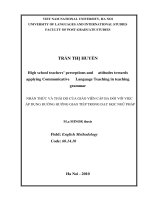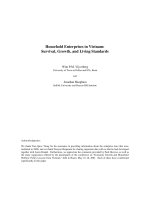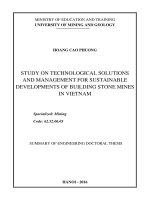Greening tvet in vietnam teachers perceptions and challenges for sustainable development
Bạn đang xem bản rút gọn của tài liệu. Xem và tải ngay bản đầy đủ của tài liệu tại đây (543.46 KB, 75 trang )
VIETNAM NATIONAL UNIVERSITY, HANOI
VIETNAM JAPAN UNIVERSITY
HOA PHUONG THAO
GREENING TVET IN VIETNAM:
TEACHERS' PERCEPTIONS AND
CHALLENGES FOR SUSTAINABLE
DEVELOPMENT
MASTER'S THESIS
VIETNAM NATIONAL UNIVERSITY, HANOI
VIETNAM JAPAN UNIVERSITY
HOA PHUONG THAO
GREENING TVET IN VIETNAM:
TEACHERS' PERCEPTIONS AND
CHALLENGES FOR SUSTAINABLE
DEVELOPMENT
MAJOR: GLOBAL LEADERSHIP
CODE: 8310210.01QTD
RESEARCH SUPERVISORS:
Prof. Dr. KAZUO KURODA
Dr. TRAN LUONG THANH
Hanoi, 2021
ACKNOWLEDGEMENTS
This study could not have been completed without the contribution of many
participations and external support. I would like to take this chance to express my
gratefulness to the people and community who assisted me in different ways during the
time I finish my research.
First of all, I would like to express my deepest gratitude to the school administrators
of Vocational College of Machinery and Irrigation (VCMI) in Dong Nai, Viet Nam for
giving me the opportunity to proceed the data collection for my thesis. Moreover, I want to
most thank for the enthusiasm of all teachers and staffs in VCMI. They always welcomed
and willingly shared with me helpful information and meaningful stories. I could not
complete this research without their contribution.
Furthermore, I would like to show the most gratefulness to the meticulous instruction
and comments from my supervisors Prof. Dr. Kazuo Kuroda and Dr. Tran Luong Thanh
that helped me overcome the most difficulties and finish my study. I am also notably
indebted to Dr. JungHyun Jasmine Ryu for her continuous patience, inspiration and
encouragement during the time of preparing and writing my thesis. I would include the
person who helped me connect with VCMI to collect valuable data - Ms. Pham Ngoc Anh
from German Corporation for International Cooperation (GIZ) in Vietnam.
Last but not least, I save my special thanks for my family and friends who are always
support me emotionally and spiritually not only in the time I worked on my thesis, but also
in two-year-time of my Master Degree.
ABSTRACT
After the establishment of Sustainable Development Goals in 2015, Education for
Sustainable Development (ESD) has been applied to all levels and forms of education.
Technical and Vocational Education and Training (TVET) is not an exception. A new path
for the development of TVET was formed and called “Greening TVET”. Nevertheless,
there have been many obstacles for TVET teachers in this renovation. Hence, this study
aims to explore the awareness and perception of TVET teachers on sustainable
development; and investigate the challenges in integrating sustainable development
knowledge into teaching process. Mixed-methods design was employed for this research.
An online survey was distributed to TVET teachers in VCMI as the first and only Center
of Excellence on Green TVET supported by GIZ in Vietnam. Then, interviews were
followed in order to have in-dept understandings on the situation. The study found that most
of TVET teachers in VCMI are aware of and have positive perception towards sustainable
development issues. Their knowledge on all dimensions of sustainable development is
sufficient and comprehensive due to the self-exploration for the Basic Module. However,
teachers cannot cover all dimensions of SD in their regular lectures due to time strain of
current curriculum. In terms of challenges, students’ awareness and consciousness were
identified as the biggest obstacles for teachers when integrating sustainable development in
teaching because the students are young and they have never received any knowledge and
training on SD before. It raises the necessary to include ESD into all levels of education,
especially since Early Childhood Education (ECE).
TABLE OF CONTENTS
LIST OF TABLES ...............................................................................................................i
LIST OF FIGURES ............................................................................................................ii
LIST OF ABBREVIATIONS .......................................................................................... iii
CHAPTER 1: INTRODUCTION ..................................................................................... 1
CHAPTER 2: LITERATURE REVIEW ......................................................................... 3
2.1 Development of TVET and Greening TVET ......................................................... 3
2.2 The development of TVET in Vietnam.................................................................. 4
2.3 Greening TVET in Vietnam ................................................................................... 7
2.4 Teachers towards Greening TVET and SD ............................................................ 9
CHAPTER 3: RESEARCH DESIGN ............................................................................. 11
3.1 Operationalization ................................................................................................ 11
3.2 Theoretical framework ......................................................................................... 12
3.3 Conceptual framework ......................................................................................... 13
3.4 Research objectives and significant of the study ................................................. 14
3.5 Research questions ............................................................................................... 15
3.6 Analytical framework ........................................................................................... 15
3.7 Expected findings ................................................................................................. 19
CHAPTER 4: METHODOLOGY .................................................................................. 20
4.1 Case selection ....................................................................................................... 20
4.2 Mixed-methods design ......................................................................................... 21
4.3 Survey ................................................................................................................... 22
4.3.1 Data collection ........................................................................................ 22
4.3.2 Data coding and analysis ........................................................................ 24
4.4 Interview ............................................................................................................... 24
4.4.1 Data collection ........................................................................................ 24
4.4.2 Data coding and analysis ........................................................................ 25
4.5 Merging quantitative and qualitative data ............................................................ 26
4.6 Limitations............................................................................................................ 26
CHAPTER 5: FINDINGS AND DISCUSSION ............................................................ 28
5.1 Awareness and perception of teachers towards SD ............................................. 28
5.1.1 Teachers’ awareness on SD .................................................................... 28
5.1.2 Teachers’ perception towards SD........................................................... 30
5.2 Implementation of SD in teaching ....................................................................... 33
5.2.1 The Basic Module on Environmental Protection, Energy and Resource
Efficiency ........................................................................................................ 33
5.2.2 Regular lectures and activities ................................................................ 34
5.3 Challenges in integrating SD into teaching .......................................................... 36
5.3.1 Challenges from school’s policy and management ................................ 37
5.3.2 Challenges from students ....................................................................... 38
5.3.3 Challenges from individuals ................................................................... 40
CHAPTER 6: CONCLUSION ........................................................................................ 42
6.1 Research summary ............................................................................................... 42
6.2 Limitations of the research ................................................................................... 44
6.3 Further research .................................................................................................... 45
REFERENCES ................................................................................................................. 46
Appendix 1. Survey form in Vietnamese ................................................................... 52
Appendix 2. Survey form in English .......................................................................... 56
Appendix 3. Interview guide in Vietnamese .............................................................. 60
Appendix 4. Interview guide in English..................................................................... 62
Appendix 5. Survey coding table ............................................................................... 64
Appendix 6. Coded raw data from the survey ............................................................ 66
LIST OF TABLES
Table 3.1. Analytical framework created by the author .................................................... 16
Table 3.2. Illustrated based on TVET in the UN Sustainable Development Goals, Part of
the 2030 Agenda for Sustainable Development ................................................................. 17
i
LIST OF FIGURES
Figure 3.1. 5-Point Likert scale illustration created by the author .................................... 13
Figure 3.2. Conceptual framework created by the author ................................................. 14
Figure 4.1. Ages of the participants in surveys ................................................................. 23
Figure 4.2. Survey participants’ faculty ............................................................................ 23
Figure 5.1. Teachers’ level of awareness .......................................................................... 28
Figure 5.2. Sources of information on SD for teachers ..................................................... 30
Figure 5.3. Teacher’s perception on social dimension of SD............................................ 30
Figure 5.4. Teacher’s perception on economic dimension of SD ..................................... 31
Figure 5.5. Teacher’s perception on environmental dimension of SD .............................. 31
Figure 5.6. Integration of SD into teaching process .......................................................... 33
Figure 5.7. Challenges in integrating SD into TVET teaching process ............................ 36
Figure 5.8. Challenges in integrating SD into teaching at school level and individual level
............................................................................................................................................ 37
ii
LIST OF ABBREVIATIONS
ADB: Asian Development Bank
AFD: French Development Agency
CoEs: Centers of Excellences
ECE: Early Childhood Education
EFA: Education for All
ESD: Education for Sustainable Development
GIZ: German Corporation for International Cooperation
JICA: Japan International Cooperation Agency
MOET: Ministry of Education and Training
MoLISA: Ministry of Labor, Invalids, and Social Affairs
SD: Sustainable Development
SDGs: Sustainable Development Goals
TVET: Technical and Vocational Education and Training
UN: United Nations
UNDP: United Nations Development Programme
UNESCO-UNEVOC: The International Centre for Technical and Vocational Education
and Training
VCMI: Vocational College of Machinery and Irrigation
VGGS: National Green Growth Strategy
iii
CHAPTER 1: INTRODUCTION
The definition of “greening” has been popular among Southeast Asia region recently
since the Sustainable Development Goals (SDGs) were officially adopted by the United
Nations (UN) in 2015 (Sustainable Development Knowledge Platform, 2015). The green
style has been broaden widely and had major impacts on various dimensions such as
economic, social and cultural development (Mustapha, 2015). Especially in education, the
values of Sustainable Development (SD) was integrated into the curriculum within various
stages of education, from early child education to higher education because education is
believed as the vital factor that raises the perception and awareness of people on their roles
and responsibility on national and international issues (Mäki & Crosier, 2019). Among all
the stages of education, TVETs is considered as the most important to SD because TVET
provides the major of the labor workforce. The workforce with sustainable awareness,
knowledge, attitude and skills will contribute tremendously to the greening national
economic development (Gu, Gomes, & Brizuela, 2011). Hence, there has been a new
orientation for the development of TVET as “Greening TVET” in order to achieve a
sustainable future. The trend of Greening TVET has been promoted and applied in several
developing countries in the region, especially the countries that are suffering the most from
climate change impacts.
However, some difficulties have been pointed out in TVET generally and Greening
TVET specifically. Most of Southeast Asian countries, for instance Brunei, Laos, Myanmar
and Indonesia, are now facing the shortage of TVET teachers in terms of both quantity and
quality due to the low rate of enrollment in TVET in the last decade (Paryono, 2015). Hence,
often times they do not have time to accumulate both field-work experience and
pedagogical skills. It is difficult for them to combine the values of SD in studying and
working process, to carry those knowledge and skills to students and also to construct a
community of high quality and greening workforce (Paryono, 2015). Furthermore, in the
process of Greening TVET, Majumdar (2009) discussed the challenges in which the
majority of them are related to teachers’ perception on SD and their pedagogical skills to
1
integrate SD into teaching. Most of the TVET teachers refer SD to the environment and
energy protection because it is familiar with the content of TVET curriculum. Then, the
pedagogy for integrating SD into teaching is not a strength of those teachers.
Among the emerging region of Southeast Asia, Vietnam is one the country that is
actively participate in achieving the target of SDGs. According to the Sustainable
Development Report in 2019, Vietnam ranked second in Sustainable Development Goal
Index only after Thailand. Vietnam decided to focus on several issues among 17 SDGs.
They vary in three aspects of SDGs: social issues specifically poverty, health improvement
and gender equality; economic growth along with climate change mitigation and adaptation
(Phan, 2019). The importance of TVET has been recognized by Vietnamese government.
Along with the National Green Growth Strategy (VGGS) which was approved in 2012,
Greening TVET was also mentioned as the new direction for TVET in order to achieve the
VGGS in term of providing skillful labor force with good knowledge and attitude towards
SD issues (Mertineit & Dang, 2016). Since then, Vietnam has actively promoted activities
in Greening TVET. Facing with the same typical situations of developing countries in the
world, the process of Greening TVET in Vietnam can become a significant study for the
purpose of enhancing Greening TVET progress in developing countries, especially within
Southeast Asia.
Therefore, with the implementation of mixed-methods design, this study aims to
explore the awareness and perception of TVET teachers on SD in the context of Vietnam,
a developing country with strong commitment on both SD and national economic
development. Furthermore, it focuses on investigating the challenges for teachers in
integrating SD into TVET teaching.
2
CHAPTER 2: LITERATURE REVIEW
2.1 Development of TVET and Greening TVET
Despite various forms of existence and level of importance, education stemmed its
origin from the dawn of humankind. Its contribution has always been a crucial part of the
evolution of civilizations throughout the world. It can be said that the ability of consecutive
transmission of knowledge and skills from ascendants made the history of human progress.
This relentless development could be divided into three great milestones that were the
Agricultural Revolution, the Industrial Revolution, and the Information Revolution. These
remarkable turning-points entirely changed the world of mankind including TVET. Along
with the advance in history, the importance of TVET has also gradually risen until the
modern-day. French respectively may be the first country to facilitate the official TVET
model with the erection of “École des ponts et chaussées” and “École Polytechnique” in
1791 and 1794 (Maclean & Wilson, 2009). Both establishments replaced the guilds systemold associations of training and education before the French Revolution. They were the first
forms of modern TVET which also paved the way for other foundations of TVET all around
the world. Since then, there have been plenty of contributions globally, which increasingly
enhanced and optimized the structure of TVET and turned it into an unsurpassed system
when it came to academics and training. With the TVET system, mankind had a plethora
of breakthroughs in history and advance with unprecedented pace.
Nevertheless, human has come along numerous pungent issues that can hardly be
radically exterminated until now. They are separated into three sections: economic, social,
and environmental problems. These matters can be a setback which significantly devastate
all the accomplishments that human have raised (Neubauer & Calame, 2018). As a result,
leaders in the world were responsible to find solutions for these disastrous obstacles.
Realizing that education has a huge prospect to help mankind tackle the challenges
threatening them, the leaders took advantage of it to influence the mindset of people.
According to Maclean and Wilson (2009), at the International Congress organized in Korea
in 1999, the long-term objectives of UN included Education for All (EFA) and ESD. With
3
these initiatives, the TVET had a historic evolution that changed the educational system of
the world. Consequently, the requirement for labor source was elevated. Nowadays, there
are plenty of qualities one needs to acquire before they apply to work that were irrelevant
in the past such as language skills, ethics, cooperation, computer skills.
In 2015, the United Nations consisting of leaders in the world adopted 17 goals of
SD model which were called SDGs as the framework until 2030 (Kioupi & Voulvoulis,
2019). Since the mark of establishing SDGs, the term of ESDs has been popular in various
areas in the world. ESD is expected to be the tool to boost the achievement of 17 SDGs by
raising awareness of the targeted goals, promoting critical understanding on SDGs in
different contexts and encouraging actions to accomplish 17 goals until 2030 (UNESCO,
2020a). With the set of standards, TVET plays an important role in conveying the
knowledge and attitude to the future generation about SD. The International Centre for
Technical and Vocational Education and Training (UNESCO-UNEVOC) mentioned the
idea of Greening TVET as a bridge between the development of TVET in the future and
the fulfillment of SDGs. According to UNESCO-UNEVOC (2017), there are five
approaches to pursuit sustainability in TVET: Greening the campus, Greening the
curriculum and training, Greening research, Greening the community and workplace and
Greening institutional culture. Among those five approached, Greening the curriculum and
training has direct impacts on students. Greening TVET has been implemented in several
countries in the world. There are activities and programs in India, Costa Rica, Nigeria,
Canada and Germany to promote Greening TVET by: including sustainability topic and
issues in the curriculum, organizing training workshop on application of new technology,
introducing to students the skills needed to work in green jobs, as well as other programs
and projects in the field of TVET, carrying out research on current situation of TVET and
developing a vocational education for SD module (Gleissner, 2012).
2.2 The development of TVET in Vietnam
Vietnam has traditionally been an intensive agricultural society; therefore,
vocational education was commonly shared by Vietnamese people in family factories or
traditional craft villages. This conventional method of apprenticeship created a professional
4
labor force for Vietnamese society while also preserving the cultural traditions of Vietnam's
traditional craft villages. TVET in Vietnam has evolved over time in response to training
demands, economic development, laws, and tactics, moving from “informal” vocational
training at standard levels to the “formal” vocational education scheme that started in the
nineteenth century (Ho, 2014). When the French colonists arrived in Vietnam, they formed
vocational schools as the first formal form of vocational training. The first three vocational
schools which based on the French model were Saigon Vocational School, Hue Vocational
School, and Hanoi Vocational School (Ho, 2014). Nevertheless, in this period, the role of
TVET formal system was ambiguous and neglected within the education system.
Doi Moi Policy 1 was an important milestone for Vietnam in many sectors. The
market-oriented economy has been applied as the economic model to promote privatization
(Bui, 2000). Vietnam changed not only in economy but also in foreign policy since the
United States left the embargo on Vietnam in 1995 (Vandemoortele & Bird, 2011). From
an underdeveloped agricultural economy with 90 percent of the population working in
agriculture, Vietnam has improved its socio-economic infrastructure to meet the
requirements of industrialization and created an environment that attracts social resources
for long-term and SD (Nguyen, 2017). The number of employees in the industries and
services has been increasing, while the number of workers in agriculture has been
decreasing. By 2016, less than 50 percent of population worked in agriculture sector;
meanwhile, up to over 24 percent of population worked in industry sectors and over 33
percent of population contribute to services (Nguyen, 2017).
As Vietnam shifted to a market-oriented economy, the TVET system was revealed
as inadequate in terms of providing a large number of employees with the necessary skills
to satisfy the needs of dynamic economic activities in Vietnam. It meant that the expertise
and experience gained in TVET programs were no longer important. Therefore, business
would have to spend time on retraining graduates (Ho & Reich, 2014). Despite the
involvement in labor market of 80 percent of working population, the number of qualified
1
In 1986, the Six Congress of the Communist Party of Vietnam approved Doi Moi Policy to transform the
economic model to market-oriented economy (Tran & Heo, 2008).
5
employees with applicable expertise and capability was limited. Asian Development Bank
(2020) described that both foreign and domestic enterprises found it difficult to recruit highlevel technical workers and managements as lack of or irrelevant of knowledge and
experience. The under quality and insufficient of TVET to the labor market could explain
the significant decrease in TVET enrollments in this period. According to World Bank, the
number of enrolment into TVET fell strongly from 171,100 in 1985 to 62,614 in 1995 (Ho
& Reich, 2014). The enrollment in colleges and higher education, on the other hand, grew
rapidly, which resulted in a labor-force imbalance.
In order to adapt the shift of labor force structure and the needs of national economic
development, TVET has been expected to contribute by providing major of labor market
with relevant knowledge and skills to the integration into globalization process. In 2006,
the Law on Vocational Training was established to respond to the need of economic
development. The law offered visionary guidelines on flexible provision, quality control,
governance and management, finance, and the position of enterprises. The law focused on
(i) promoting participation in the vocational training network and enhancing the standard
of vocational training; (ii) improving quality by updating syllabuses, curricula, teaching
practices, trainer production, modernized facilities, and research; (iii) upgrading several
vocational training institutions to international and global levels; (iv) focusing on
vulnerable populations and assisting target populations; and (v) “socializing” (or
privatizing) vocational training by motivating stakeholders to establish vocational training
institutions (Asian Development Bank, 2014). The Law on Vocational Training 2006
framed and strengthened the TVET system in Vietnam. Since then, TVET programs in
Vietnam have included both short-term and long-term programs under the management of
Ministry of Education and Training (MOET) and Ministry of Labor, Invalids, and Social
Affairs (MoLISA). Students can attend vocational courses after they finish secondary
school or high school or short-term courses without any requirement on previous education
(Asian Development Bank, 2014). Over the course of one to four years, students receive
professional and vocational instruction, learning experience and expertise in both theory
and application in order to be qualified to the world of work. After implementing the Law
6
on Vocational Training 2006, TVET system in Vietnam had a significant transformation.
In 2008, there were 37,760 TVET institution in all levels. This number increased strongly
to over 50,000 including both vocational training centers, secondary vocational training
schools, vocational training colleges and vocational training institutions in 2010.
Government largely motivated the increase in the number of vocational colleges, while
non-state actors contributed more to the growth in vocational training centers (Hilal, 2013).
Nevertheless, after implementing The Law on Vocational Training 2006,
Vietnamese TVET system was still lack of practical characteristics and the linkage between
study and the world of work. Hence, on November 27th, 2014, the updated Law on
Vocational Education and Training 2015 was passed by the 13th National Assembly in
order to improve the quality if TVET in Vietnam and to meet the requirements of regional
and international integration (Directorate of Vocational Education and Training, 2015). The
Law on Vocational Education and Training 2015 has been guided by The Directorate for
Vocational Education and Training at MoLISA (OECD, 2021). The Law on Vocational
Training not only concerned the operation, promotion and quality of TVET sector in
Vietnam, but also encouraged the establishment of foreign-invested education institutions
(Directorate of Vocational Education and Training, 2015). Vietnam has received large
amount of support from international partners such as Government of the Republic of Korea,
Government of Germany, Asian Development Bank (ADB), The French Development
Agency (AFD) and Japan International Cooperation Agency (JICA). Especially, GIZ has
cooperated with Vietnamese government on a long-term program named “Reform of TVET
in Vietnam” (GIZ, 2021).
2.3 Greening TVET in Vietnam
Vietnam was considered as one of the countries with the most abundant and
diversified forest and aquatic resources. However, this has been a significant developing
country suffering from the high demands of natural resources and huge impact of climate
change recently. The Earth Overshoot Day which calculated by the Global Footprint
Network marks the date when mankind's demand on nature exceeds the capacity of the
planet's habitats to recover annually (Minh, 2019b). In 2018, Vietnam was the country
7
which had the latest mark on December 21st. Nevertheless, in 2019, that date came earlier
on October 08th. On the same trend as many other countries, Vietnam has been overconsuming of natural resources due to the industrialization and modernization (Minh,
2019b). According to the Global Climate Risk Index, from 1999 to 2018, Vietnam was
among top ten countries which were most affected by climate change. In the same period,
Vietnam experienced over 220 extreme climate events, which resulted in annual losses of
285 deaths and more than $2 billion (Minh, 2019a).
In response to these issues, Vietnam started setting a plan to achieve economic
growth along with compromising with SD and social development. Vietnamese
government approved the VGGS in 10-year period from 2011 to 2020 and vision to 2050
(Mertineit & Dang, 2016). The VGGS focused on mapping the development path to balance
economic growth and social improvement. There was a significant change in the growth
model in order to keep up with the global trend of SD. Along the “greening” process, the
shortage of skillful workforce has been seen as the most barrier. Therefore, TVET has been
considered as the source of qualified labor force for the green economy and (Mertineit &
Dang, 2016). The Decision No. 1393/QĐ-TTg on Approval of the VGGS clarified the
importance of integrating SD into all levels of education, especially TVET (Vietnam
Government, 2012).
Since the approval of VGGS in 2012, Vietnam has been working on building the
framework for Greening TVET within the country. Vietnam has been adopted the
knowledge and experience on Greening TVET through international support. There has
been many conferences, campaigns and activities organized in with the aim at raising the
awareness of TVET teachers and students on SD. For instance, from December 2019 to
May 2020, the campaign for “Eco-Lifestyle and Reducing Plastic Waste in Schools” was
implemented at Long An Vocational College and VCMI with the support of GIZ. The
campaign includes activities such as managing of waste at schools, developing of action
plans to reduce waste at schools, and building a foundation for develop eco-friendly
lifestyle. The program provides necessary knowledge and skills related to the environment
to orient green careers in the future (Center for Development of Community and
8
Environmental Initiatives, 2021). Furthermore, The Basic Module on Environmental
Protection, Energy and Resource Efficiency had been designed among CoEs supported by
GIZ and tested within VCMI for an academic year since 2017. After that, the module was
launched in 2018 as a compulsory subject in nearly 30 TVET schools. The module includes
three related topics which are energy efficiency, waste management and hazardous
substance handling. The basic module focuses on developing practical skills, with some
field trips to businesses, focusing on clarifying the consequences of behavior. Theory is
only included when needed to help students understand clear content (Vietnam Association
for Vocational Education - Training and Social Work Profession, 2018). The advantage of
this module is that it can be flexibly integrated into any vocational training program
nationwide (Directorate of Vocational Education and Training, 2018).
2.4 Teachers towards Greening TVET and SD
TVET is considered as a key to achieve SD because TVET provides human
resources that will directly work and deal with issues related to environments. Moreover,
SD consists of three criteria: economic, socio-cultural and environmental development.
TVET play an essential role in framing the future of a nation (Paryono, 2017). Nevertheless,
there have been many challenges in combining SD and TVET. Majumdar (2009) described
5 major obstacles for SD in TVET. Among those challenges, the mis-understanding of the
definition and scope of SD and pedagogy innovation were highlighted as the most
challenging for Greening TVET. TVET teachers easily misunderstand SD with the
environmental aspect only and ignore the link with economic and socio-cultural
development. Regarding the pedagogy in TVET, most of teachers focus on delivering the
pure technical knowledge but focus on how to deliver other skills or the most effective
pedagogy.
Several research demonstrated that teachers understand the importance and positive
effects of SD. They agree that SD is vital for the development of TVET, especially in
Southeast Asian countries. Ramli, Rasul, & Affandi (2019) highlighted that over 85 percent
of over 300 teachers in Malaysia agreed to apply green skills in teaching and learning
process. However, there is a lack of policy frameworks that give TVET teachers chances
9
to be prepared. In Vietnam, there is a shortage of teachers trained in green issues, which
includes technical knowledge and skills, pedagogical experience and SD related knowledge
(Mertineit & Dang, 2016). There are limited studies which illustrate the perception of
teachers on SD and challenges that they are facing with integrating SD in TVET. Therefore,
this research aims to collect the data that directly portrays actual situation of teachers
towards SD.
10
CHAPTER 3: RESEARCH DESIGN
3.1 Operationalization
Technical and Vocational Education and Training
TVET is “education, training and skills development relating to a wide range of
occupational fields, production, services and livelihoods (UNESCO, 2015)”.
Sustainable Development
The term SD which was mentioned in Our Common Future: Report of the Word
Commission on Environment and Development in 1987 refers to the “development that
meets the needs of the present without compromising the ability of future generations to
meet their own needs (UNCED, 1987)”.
Sustainable Development Goals
According to United Nations Development Programme (UNDP), The United
Nations approved the Sustainable Development Goals (SDGs), also known as the Global
Goals, in 2015 as a global call to action to eradicate poverty, preserve the environment, and
guarantee that by 2030, all people enjoy peace and prosperity. The 17 SDGs are
interconnected in that they acknowledge that actions in one area impact outcomes in others
and that progress must balance social, economic, and environmental sustainability (UNDP,
2018).
Education for Sustainable Development
Climate change, environmental devastation, biodiversity loss, poverty, and
inequality are all interlinked global concerns that education for sustainable development
(ESD) equips learners of all ages with the information, skills, values, and attitudes
necessary to confront them. Students and learners of all ages must be prepared to develop
answers to today's and tomorrow's difficulties. Education should be transformational,
11
enabling us to make valid decisions and take individual and communal action to improve
our society and protect the environment (UNESCO, 2020b).
Greening TVET
“Greening TVET is a continuing process of adapting knowledge and practices with
the aim of aligning them with the overall concept of sustainability (UNESCO-UNEVOC,
2017)”.
3.2 Theoretical framework
Perception is a psychological concept which has been defined by several scholars.
Whatever people perceive or learn about called perception. It's a concept of something that
has been given to the senses (Graham, 1869). According to Pickens (2005), the process
through which organisms interpret and arrange sensations to generate a meaningful
experience of the world is known as perception. A scenario or stimuli is presented to a
person. Based on past experiences, the person interprets the stimuli into something
significant to him or her. However, the most important thing is that what a person
understands or sees may differ significantly from reality due to his or her own experiences
(Pickens, 2005). Along with attitudes and views, perceptions are examples of qualitative
characteristics that may be quantified. Meanwhile, evaluating something that cannot be
quantified using traditional measuring techniques has been a difficulty (Joshi, Kale,
Chandel, & Pal, 2015).
Nevertheless, the apparent need for this quantification stems from the urge to convert
a person's subjective world into an objective reality. Walberg (1977) argued that one’s
perception may be accurately assessed by calculating indexes of agreement with statements
that describe the topic or phenomenon being studied. Therefore, there have been several
attempts to theoretically construct the psychometrics techniques as the valid instruments
for quantifying qualitative information as human perceptions. According to Joshi et al.
(2015), among those theoretical construct for measurement, one of the most flexible
solutions was followed by the operationalization of abstract ideas/experiences/issues under
research into a few assertions (items) that are primarily influenced by the study's purposes.
12
This allows the contents (items) of such scales/models to be more adaptable and tailored to
the needs of the researcher. This led to the creation on Likert scale, which has been used
widely and effectively in the social science and educational research. In 1932, the Likert
scale was created to evaluate “attitude” in a scientifically recognized and validated manner.
The Likert scale can assist the problem of determining how to quantify these subjective
preference thoughts, feelings, and actions in a verified and accurate way. Based on the
flexible and validity of Likert scale, this research applies the psychometric of 5-Point Likert
scale, which defines as “a type of psychometric response scale in which responders specify
their level of agreement to a statement typically in five points: (1) Strongly disagree; (2)
Disagree; (3) Neither agree nor disagree; (4) Agree; (5) Strongly agree” and described in
Figure 3.1 below, to measure the teachers’ perception on SD within TVET (Preedy &
Walson, 2010).
Figure 3.1. 5-Point Likert scale illustration created by the author
Source: Preedy & Walson, 2010
3.3 Conceptual framework
A conceptual framework is a network of interconnected concepts that, when
combined, give a thorough knowledge of phenomena. However, a conceptual framework
is more than just a group of concepts. It is a construct in which each notion plays an
important function. (Jabareen, 2009). This research aims to explore the trend of Greening
TVET in developing countries where the “green” idea has been popular. The movement of
Greening TVET in this paper is viewed through the perspective of teachers who are focal
points of receiving and transferring new knowledge to students. Teachers are the agents
who apply and experience the most in Greening the curriculum and training, one of the
13
most effective approaches to pursuit Greening TVET. In order to understand teachers’
perspectives, this research applies and modifies the model of Taylor & Creech (2012) and
uses the criteria of teachers’ awareness and perception towards SD and challenges on
integrating SD into teaching. These elements help generalize the teachers’ perspectives on
Greening TVET through the Greening the curriculum and training approach. The detailed
conceptual framework refers to Figure 3.2 below.
Figure 3.2. Conceptual framework created by the author
3.4 Research objectives and significant of the study
Among ASEAN countries which set the double targets in achieving both national
economic development and SD, Vietnam is one of the countries with the earliest and
strongest commitment to the SDGs (Quang, 2019). Moreover, Vietnam is receiving a huge
international support in enhancing Greening TVET due to the change on educational
policies since 2006 (Australian Education International, 2012). The study of Greening
TVET in Vietnam can assist other developing countries with similar targets and situation.
Hence, this research aims to inspect the awareness of TVET teachers in Vietnam on SD
and their perception towards SD within TVET. Moreover, the challenges for teachers in
14
integrating SD into teaching are explored through the case study of VCMI as the pioneer
on Greening TVET in Vietnam.
3.5 Research questions
In accordance with the research objectives, detailed research questions are as follows.
1. What are TVET teachers’ awareness and perception on SD within TVET?
1.1 What is TVET teachers’ awareness on SD?
1.2 What is TVET teachers’ perception on social, economic and environmental
dimensions of SD within TVET?
2. What are challenges for TVET teachers in integrating SD in teaching?
2.1 What are challenges for TVET teachers in integrating SD in teaching at
school level?
2.2 What are challenges for TVET teachers in integrating SD in teaching at
individual level?
3.6 Analytical framework
The analytical framework combines three main parts in relevant with the research
objectives and questions: teachers’ awareness on SDGs, perception toward SD within
TVET and challenges on integrating SD into teaching. The detailed analytical framework
is described in Table 3.1 below. In Taylor & Creech (2012)’s research, the awareness of
teachers on ESD was discovered through questions for instance “Are you familiar with the
concept of Education for Sustainable Development (ESD)?” and “Have you read about or
received training on how to incorporate ESD into the technical-vocational curriculum?”.
The analytical framework for teachers’ awareness on SD is adopted from Taylor & Creech
(2012)’s work on TVET for ESD in Manitoba, Canada. There are two categories supporting
to explore the teachers’ awareness on SD. They are level of awareness and sources of the
awareness, in which level of awareness is expected to express through the number of SDGs
that teachers can clarify the themes.
15
Table 3.1. Analytical framework created by the author
Category
1
2
3
Awareness
on SDGs
Perception
towards SD
within
TVET
Challenges
on
integrating
SD into
teaching
Variables
Level of awareness
Number of SDGs with clarified themes
Sources of the
awareness
Training courses, news and media
Social dimension
Quality education
Economic dimension
Decent work and economic growth
Environmental
dimension
Climate action
School level
Difficulties related to school’s policy
and management
Difficulties related to students
Individual level
Difficulties related to teachers
UNESCO-UNEVOC (2017) described the link between TVET and SDGs in four
goals which comprehend all three dimensions of SD: environmental, economic and social
dimensions. These four goals are SDG 4: Quality education, SDG 6: Clean water and
sanitation, SDG 8: Decent work and economic growth and SDG 13: Climate action. In each
goal, the elements that are related to TVET are mentioned specifically in targets showed in
Table 3.2 below. Regarding the analytical framework for teachers’ perception on SD within
TVET, three SDGs are selected to represent each dimension of SD. The selected goals are
SDG 4: Quality education, SDG 8: Decent work and economic growth and SDG 13:
Climate action. The details of targets which are relevant to TVET are used to construct the
analytical framework and questions in the survey.
16









